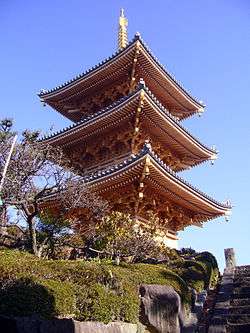塔
| ||||||||
Translingual
Han character
塔 (radical 32, 土+10 in Chinese, 土+9 in Japanese, 13 strokes in Chinese, 12 strokes in Japanese, cangjie input 土廿人口 (GTOR), four-corner 44161, composition ⿰土荅)
References
- KangXi: page 235, character 14
- Dai Kanwa Jiten: character 5332
- Dae Jaweon: page 473, character 7
- Hanyu Da Zidian: volume 1, page 460, character 6
- Unihan data for U+5854
Chinese
| simp. and trad. |
塔 | |
|---|---|---|
| variant forms | 墖 | |
Glyph origin
| Characters in the same phonetic series (合) (Zhengzhang, 2003) | |
|---|---|
| Old Chinese | |
| 龕 | *kʰuːm |
| 媕 | *quːm, *qromʔ, *qɯːm, *qramʔ, *qɯːb |
| 頜 | *ɡuːmʔ, *kuːb |
| 答 | *tkuːb |
| 畣 | *tkuːb |
| 荅 | *tkuːb |
| 嗒 | *tuːb, *tʰoːb |
| 褡 | *tuːb, *toːb |
| 撘 | *tuːb |
| 搭 | *tuːb, *tʰoːb |
| 榙 | *tkuːb, *ɡuːb |
| 佮 | *tkʰuːb, *kuːb, *quːb, *quːb |
| 蛤 | *kuːb |
| 鴿 | *kuːb |
| 合 | *kuːb, *ɡuːb |
| 郃 | *kuːb, *ɡuːb |
| 匌 | *kuːb, *kʰuːb |
| 鉿 | *kuːb |
| 閤 | *kuːb |
| 鞈 | *kuːb, *kruːb |
| 韐 | *kuːb, *kruːb |
| 鮯 | *kuːb |
| 哈 | *ŋɡuːb |
| 姶 | *quːb, *quːb |
| 欱 | *qʰuːb, *qʰruːb |
| 盒 | *ɡuːb |
| 耠 | *ɡuːb |
| 詥 | *ɡuːb |
| 塔 | *tʰuːb |
| 鞳 | *tʰoːb |
| 劄 | *rtuːb |
| 跲 | *kruːb, *kob, *ɡob |
| 袷 | *kruːb, *ŋkob |
| 餄 | *kruːb |
| 恰 | *kʰruːb |
| 帢 | *kʰruːb |
| 洽 | *ɡruːb |
| 祫 | *ɡruːb |
| 珨 | *ɡruːb |
| 烚 | *ɡruːb |
| 歙 | *qʰjob, *qʰrub |
| 湁 | *tkʰub |
| 拾 | *ɡjub |
| 給 | *krub |
| 翕 | *qʰrub |
| 噏 | *qʰrub |
| 潝 | *qʰrub |
| 熻 | *qʰrub |
| 嬆 | *qʰrub |
| 翖 | *qʰrub |
| 闟 | *qʰrub |
Phono-semantic compound (形聲, OC *tʰuːb) : semantic 土 + phonetic 荅 (OC *tkuːb).
Pronunciation
Compounds
Japanese
Readings
Compounds
- 五輪の石塔 (gorin no sekitō), 五輪の塔 (gorin no tō): a five-ring or five-level stone stupa
- 仏塔 (buttō): a Buddhist reliquary stupa; a Buddhist temple pagoda or stupa
- 五重塔 (gojū no tō), 五重の塔 (gojū no tō): a five-storey pagoda
- 石塔 (sekitō): a stone pagoda or stupa; a Buddhist tombstone
- 三重塔 (sanjū no tō), 三重の塔 (sanjū no tō): a three-storey pagoda
- 塔屋 (tōya): a penthouse; a structure on top of a building, possibly the top of the elevator shaft, the stairs, ventilation equipment, or a water tower
- 塔花 (tōbana): genus Clinopodium, including wild mints and basils; slender wild basil (Clinopodium gracile)
- 塔型クレーン (tōgata kurēn): a tower crane
- 塔克拉瑪干砂漠 (Takuramakan sabaku): the Taklamakan Desert
- 塔主 (tassu), 塔司 (tassu): job title for the caretaker of a Buddhist cemetery
- 塔頭 (tatchū), 塔中 (tatchū): in Zen Buddhism, the location of a stupa for a past master or founder; the title of the monk in charge of that stupa; a small chapel within a larger temple
- 塔頭 (tatchō): an old grave; a graveyard, a cemetery
- 塔婆 (tōba): a stupa: short for 卒塔婆 (sotōba)
- 塔廟 (tōbyō): a Buddhist reliquary stupa
- 塔望遠鏡 (tōbōenkyō): a tower telescope, a tower observatory
- 塔里木 (Tarimu): the Tarim Basin
Etymology 1

/tapu/ > /taɸu/ > */tawu/ > /tau/ > /tɔː/ > /toː/
From Middle Chinese 塔 (MC tʰɑp̚, “tower, pagoda, spire”).
An abbreviation for 卒塔婆 (sotoba , sotōba), a transliteration of Sanskrit स्तूप (stūpa, “heap”) .
Noun
塔 (hiragana とう, rōmaji tō, historical hiragana たふ)
- a tower (structure)
- 二つの塔
- Futatsu no Tō
- The Two Towers
- 二つの塔
- (Buddhism) a pagoda, a stupa
- (Christianity) a steeple, spire
- (of a castle or fortification) a turret
Derived terms
- 塔の層 (tō no koshi): the stacked floors of a pagoda
- 塔ノ沢温泉 (Tō no Sawa onsen): an onsen (hot spring) in Hakone, Kanagawa Prefecture
Idioms
- 塔は下から組め (tō wa shita kara kume): “build a tower from the bottom up” → no good building without a good foundation
Suffix
Etymology 2
First appears in the Engishiki compilation of laws created in the early 900s, spelled phonetically in kanji as 阿良良伎 (araragi). Spelled as 蘭, araragi literally means “wild onion” and refers to the wild rocambole, possibly hardneck garlic, notable for its tall green stalk sticking straight up. Used as a euphemism for 塔[2][1] (tafu at the time), as that word's Buddhist connotations were viewed as taboo in contexts having to do with the religious center of Itsuki no Miya (斎宮, also known as Saikū).
Noun
塔 (hiragana あららぎ, rōmaji araragi)
Derived terms
- 塔舞 (Araragimai): the title of a piece of bugaku Japanese court dance
References
- 2006, 大辞林 (Daijirin), Third Edition (in Japanese), Tōkyō: Sanseidō, →ISBN
- 1988, 国語大辞典(新装版) (Kokugo Dai Jiten, Revised Edition) (in Japanese), Tōkyō: Shogakukan
Korean
Hanja
塔 • (tap) (hangeul 탑, McCune–Reischauer t'ap)
- This term needs a translation to English. Please help out and add a translation, then remove the text
{{rfdef}}.